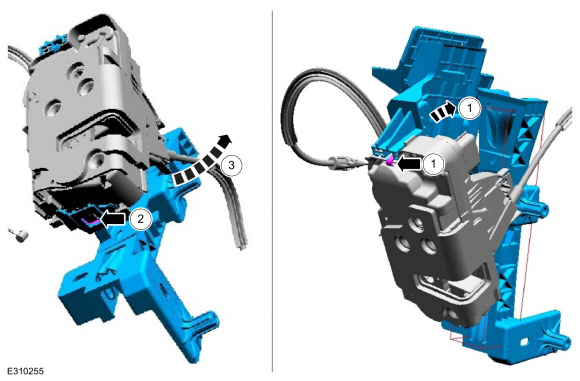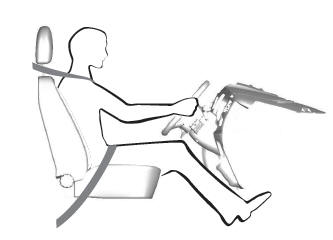Refer to Wiring Diagrams Cell 42 for schematic and connector information.
Normal Operation and Fault Conditions
When the ABS module receives a parking brake apply or release
request, the ABS module sends voltage to the parking brake actuator
motors. The ABS
module also monitors the current draw of the actuator motors to
determine when the brake pads contact the brake disc, to determine when
the appropriate amount of clamping force is being applied to the brake
disc and to determine when the brake pads are retracted to their start
position. A HS-CAN issue or concern results in a failure to release the
parking brake. The ABS
module runs self-tests before, during and after an apply or release
request. These self-tests are done to determine parking brake system
functionality. High actuator motor circuit resistance, a short to
ground, a short to voltage, an open circuit, a mechanical or electrical
failure of the actuator motor or an internal failure of the ABS module
may cause one or more of these self-tests to fail resulting in the ABS
module setting one or more Diagnostic Trouble Codes (DTCs). The
actuator motors have a serviceable jumper harness connecting the
actuator motor to the body harness at C410 for the LH actuator motor and
RH actuator motor.
DTC Fault Trigger Conditions
| DTC |
Description |
Fault Trigger Condition |
| ABS C1034:97 |
Park Brake: Component Or System Operation Obstructed Or Blocked |
This DTC
will be set if the park brake switch is in Release or Apply for longer
than a set amount of time continously while vehicle is at a standstill.
|
| ABS C1A43:98 |
Motor Supply: Component Or System Over Temperature |
This DTC sets when the temperature of the ABS module Field Effect Transistor reaches a preset limit.
|
| ABS C2005:1B |
Right Actuator: Circuit Resistance Above Threshold |
This DTC
sets in continuous memory and on-demand if during an apply (clamping)
command, the measured resistance in the motor circuit is higher than a
predetermined threshold.
|
| ABS C2006:1B |
Left Actuator: Circuit Resistance Above Threshold |
This DTC
sets in continuous memory and on-demand if during an apply (clamping)
command, the measured resistance in the motor circuit is higher than a
predetermined threshold.
|
| ABS C2005:71 |
Right Actuator: Actuator Stuck |
This DTC sets in continuous memory and on-demand if during an apply or
release command, the ABS module detects no movement of the actuator
motor.
|
| ABS C2006:71 |
Left Actuator: Actuator Stuck |
This DTC sets in continuous memory and on-demand if during an apply or
release command, the ABS module detects no movement of the actuator
motor.
|
| ABS C2007:13 |
Right Motor: Circuit Open |
This DTC sets in continuous memory and on-demand if the ABS module
detects a difference in the current between the positive side and the
negative side of the actuator motor.
|
| ABS C2008:13 |
Left Motor: Circuit Open |
This DTC sets in continuous memory and on-demand if the ABS module
detects a difference in the current between the positive side and the
negative side of the actuator motor.
|
| ABS C2007:1C |
Right Motor: Circuit Voltage Out Of Range |
This DTC sets in continuous memory and on-demand if the ABS module
detects a short to ground or a short to voltage on the actuator motor
circuits.
|
| ABS C2008:1C |
Left Motor: Circuit Voltage Out Of Range |
This DTC sets in continuous memory and on-demand if the ABS module
detects a short to ground or a short to voltage on the actuator motor
circuits.
|
| ABS C2007:92 |
Right Motor: Performance Or Incorrect Operation |
This DTC sets in continuous memory and on-demand if the ABS
module detects a current greater than 23 amps after an apply or
release request, detects a mismatch in motor control (power instead of
ground or ground instead of power), or detects a power loss that exceeds
a predetermined threshold during an apply or release function.
|
| ABS C2008:92 |
Left Motor: Performance Or Incorrect Operation |
This DTC sets in continuous memory and on-demand if the ABS
module detects a current greater than 23 amps after an apply or
release request, detects a mismatch in motor control (power instead of
ground or ground instead of power), or detects a power loss that exceeds
a predetermined threshold during an apply or release function.
|
| HVAC B1541:11 |
Auto Hold LED: Circuit Short To Ground |
This DTC sets in continuous memory and on-demand if the HVAC
module detects a short to ground. The Autohold indicator will not be
illuminated and the Autohold button function is deactivated.
|
| HVAC B1541:15 |
Auto Hold LED: Circuit Short To Battery Or Open |
This DTC sets in continuous memory and on-demand if the HVAC
module detects a short to battery or open. The Autohold indicator will
always be illuminated and the Autohold button function is deactivated.
|
Possible Sources
- Automatic release functional requirements not met
-
BCM concern
-
PCM concern
- Wiring, terminals or connectors
- Brake caliper
- Parking brake actuator motor
-
ABS module
-
EPB switch
|
| E1 CHECK FOR ABS (ANTI-LOCK BRAKE SYSTEM)
MODULE DIAGNOSTIC TROUBLE CODES (DTCS) |
|
NOTE:
A HS-CAN issue or concern results in a failure to release the parking brake.
-
Using a diagnostic scan tool, carry out the ABS module self-test.
Are any of the Diagnostic Trouble Codes (DTCs) listed in the DTC Fault Trigger Conditions table present in the ABS module?
| No |
If there are any "invalid data" or "no communication" Diagnostic Trouble Codes (DTCs) present, GO to the DTC Chart: ABS Module.
If there are no "invalid data" or "no communication" Diagnostic Trouble Codes (DTCs) present, GO to E2
|
|
| E2 VERIFY AUTOMATIC RELEASE FUNCTIONALITY |
-
With the transmission in PARK, apply the parking brake.
-
Fasten the driver seat belt.
-
NOTE:
When the accelerator pedal is pressed, the parking brake releases automatically.
Press the accelerator pedal until the parking brake releases and the vehicle begins to move.
Does the parking brake automatically release when the accelerator pedal is pressed?
| Yes |
The system is operating correctly at this time. The
concern may have been due to the automatic release functional
requirements not being met. EXPLAIN the automatic release functional
requirements to the customer.
REFER to: Parking Brake - System
Operation and Component Description (206-05 Parking Brake and Actuation,
Description and Operation).
|
|
| E3 CHECK THE HVAC (HEATING, VENTILATION AND AIR CONDITIONING)
MODULE FOR DIAGNOSTIC TROUBLE CODES (DTCS) |
-
Using a diagnostic scan tool, carry out the HVAC Module self-test.
-
Retrieve and record all HVAC Module Diagnostic Trouble Codes (DTCs).
Are Diagnostic Trouble Codes (DTCs) B1541:11 or B1541:15 present?
|
| E4 CHECK THE PARKING BRAKE SWITCH AUTOHOLD IN THE APPLIED AND UNAPPLIED POSITIONS |
-
Disconnect EPB switch C3675.
-
Push Autohold button ON and OFF.
-
Measure:
Auto Hold Switch
|
Positive Lead
|
Measurement / Action
|
Negative Lead
|
|
C3675-11
Component side
|

|
C3675-2
Component side
|
Auto Hold Indicator
|
Positive Lead
|
Measurement / Action
|
Negative Lead
|
|
C3675-5
Component side
|

|
C3675-2
Component side
|
Are the resistances less than 3 ohms?
| No |
Replace the EPB switch
REFER to: Parking Brake Switch (206-05 Parking Brake and Actuation, Removal and Installation).
|
|
| E5 CHECK THE PARKING BRAKE SWITCH GROUND CIRCUIT FOR AN OPEN |
-
Measure:
|
Positive Lead
|
Measurement / Action
|
Negative Lead
|
|
C3675-2
|

|
Ground
|
Is the resistance less than 3 ohms?
|
| E6 CHECK THE PARKING BRAKE SWITCH AUTOHOLD CIRCUITS FOR AN OPEN |
-
Disconnect the HVAC module C228A.
-
Measure:
|
Positive Lead
|
Measurement / Action
|
Negative Lead
|
|
C228A-6
|

|
C3675-5
|
|
C228A-5
|

|
C3675-11
|
Are the resistances less than 3 ohms?
| No |
REPAIR the effected circuit.
|
|
| E7 CHECK THE PARKING BRAKE SWITCH AUTOHOLD CIRCUITS FOR A SHORT TO GROUND |
-
Measure:
|
Positive Lead
|
Measurement / Action
|
Negative Lead
|
|
C228A-6
|

|
Ground
|
|
C228A-5
|

|
Ground
|
Are the resistances greater than 10,000 ohms?
| No |
REPAIR the effected circuit.
|
|
| E8 CHECK THE PARKING BRAKE SWITCH AUTOHOLD CIRCUITS FOR A SHORT TO BATTERY VOLTAGE |
-
Measure:
|
Positive Lead
|
Measurement / Action
|
Negative Lead
|
|
C228A-6
|

|
Ground
|
|
C228A-5
|

|
Ground
|
Is any voltage present
| Yes |
REPAIR the effected circuit.
|
|
| E9 CHECK THE ACTUATOR MOTOR CIRCUITS FOR AN OPEN |
-
Disconnect ABS module C135A.
-
Disconnect the suspect parking brake actuator motor electrical connector.
-
For the RH actuator motor, measure:
|
Positive Lead
|
Measurement / Action
|
Negative Lead
|
|
C4479-1
|

|
C135A-12
|
|
C4479-2
|

|
C135A-13
|
-
For the LH actuator motor, measure:
|
Positive Lead
|
Measurement / Action
|
Negative Lead
|
|
C4478-1
|

|
C135A-3
|
|
C4478-2
|

|
C135A-2
|
Are the resistances less than 3 ohms?
| Yes |
If DTC C2007:13 or C2008:13 are the only Diagnostic Trouble Codes (DTCs) are present, GO to E13
If other Diagnostic Trouble Codes (DTCs) are present, GO to E10
|
| No |
INSPECT the actuator motor jumper harness and
connectors for correct routing, damaged connectors, spread terminals,
bent or pushed-out pins or any signs of corrosion. INSTALL a new jumper
harness as necessary.
If the jumper harness is OK, REPAIR the circuit.
|
|
| E10 CHECK THE ACTUATOR MOTOR CIRCUITS FOR A SHORT TO GROUND |
-
For the RH actuator motor, measure:
|
Positive Lead
|
Measurement / Action
|
Negative Lead
|
|
C4479-1
|

|
Ground
|
|
C4479-2
|

|
Ground
|
-
For the LH actuator motor, measure:
|
Positive Lead
|
Measurement / Action
|
Negative Lead
|
|
C4478-1
|

|
Ground
|
|
C4478-2
|

|
Ground
|
Are the resistances greater than 10,000 ohms?
| No |
INSPECT the actuator motor jumper harness and
connectors for correct routing, damaged connectors, spread terminals,
bent or pushed-out pins or any signs of corrosion. INSTALL a new jumper
harness as necessary.
If the jumper harness is OK, REPAIR the circuit.
|
|
| E11 CHECK THE ACTUATOR MOTOR CIRCUITS FOR A SHORT TOGETHER |
-
For the RH actuator motor, measure:
|
Positive Lead
|
Measurement / Action
|
Negative Lead
|
|
C4479-1
|

|
C4479-2
|
-
For the LH actuator motor, measure:
|
Positive Lead
|
Measurement / Action
|
Negative Lead
|
|
C4478-1
|

|
C4478-2
|
Is the resistance greater than 10,000 ohms?
| No |
INSPECT the actuator motor jumper harness and
connectors for correct routing, damaged connectors, spread terminals,
bent or pushed-out pins or any signs of corrosion. INSTALL a new jumper
harness as necessary.
If the jumper harness is OK, REPAIR the circuit.
|
|
| E12 CHECK THE ACTUATOR MOTOR CIRCUITS FOR A SHORT TO VOLTAGE |
|
NOTE:
Performing this step sets Diagnostic Trouble Codes (DTCs) in the ABS module.
-
For the RH actuator motor, measure:
|
Positive Lead
|
Measurement / Action
|
Negative Lead
|
|
C4479-1
|

|
Ground
|
|
C4479-2
|

|
Ground
|
-
For the LH actuator motor, measure:
|
Positive Lead
|
Measurement / Action
|
Negative Lead
|
|
C4478-1
|

|
Ground
|
|
C4478-2
|

|
Ground
|
Is any voltage present?
| Yes |
INSPECT the actuator motor jumper harness and
connectors for correct routing, damaged connectors, spread terminals,
bent or pushed-out pins or any signs of corrosion. INSTALL a new jumper
harness as necessary.
If the jumper harness is OK, REPAIR the circuit.
|
|
| E13 CHECK THE BRAKE CALIPER BALL SCREW DRIVE |
-
Remove the suspect actuator motor.
REFER to: Parking Brake Actuator Motor (206-05 Parking Brake and Actuation, Removal and Installation).
-
Using a torque wrench, turn the ball screw drive on
the brake caliper counterclockwise. It should not take more than 5 Nm
(44 lb-in) to turn the ball screw drive.
Does the ball screw drive turn with less than 5 Nm (44 lb-in) or turning force?
| No |
INSTALL a new brake caliper.
REFER to: Brake Caliper (206-04 Rear Disc Brake, Removal and Installation).
|
|
| E14 CHECK THE ACTUATOR MOTOR RESISTANCE |
-
Measure:
|
Positive Lead
|
Measurement / Action
|
Negative Lead
|
|
Suspect Actuator Motor Electrical Connector Pin-1, Component Side
|

|
Suspect Actuator Motor Electrical Connector Pin-2, Component Side
|
Is the resistance less than 500 ohms?
| No |
INSTALL a new parking brake actuator motor.
REFER to: Parking Brake Actuator Motor (206-05 Parking Brake and Actuation, Removal and Installation).
|
|
| E15 VERIFY ALL WIRING CONNECTIONS |
-
Disconnect ABS module and the suspect parking brake actuator motor.
-
Using a good light source, inspect ABS module C135A, parking brake actuator motor C4478 or C4479 for the following:
-
corrosion - install new connector or terminal and clean the module pins
-
damaged or bent pins - install new terminals or pins
-
pushed-out pins - install new pins as necessary
-
spread terminals - install new terminals as necessary
Are the connectors free of corrosion, damaged pins, bent pins, pushed-out pins and spread terminals?
| No |
REPAIR the connector or terminals.
Refer to Wiring Diagrams Cell 5 for schematic and connector information.
|
|
| E16 CHECK FOR CORRECT ABS (ANTI-LOCK BRAKE SYSTEM)
MODULE OPERATION |
-
Connect ABS module C135A. Make sure it seats and latches correctly.
-
Connect the suspect parking brake actuator motor connector. Make sure it seats and latches correctly.
-
Perform the following steps to restore parking brake switch functionality:
-
Place the switch in the APPLY position.
-
Release the switch to the NEUTRAL position.
-
Place the switch in the RELEASE position.
-
Release the switch to the NEUTRAL position.
-
Repeat the 4 steps.
-
Operate the system and determine if the concern is still present.
Is the concern still present?
| Yes |
CHECK OASIS for any applicable service articles: TSB , GSB , SSM or FSA
. If a service article exists for this concern, DISCONTINUE this test
and FOLLOW the service article instructions.
If no Technical Service Bulletins (TSBs) exist for this concern, INSTALL a new ABS module.
REFER
to: Hydraulic Control Unit (HCU) - Vehicles With: Vacuum Brake Booster
(206-09 Anti-Lock Brake System (ABS) and Stability Control, Removal and
Installation).
|
| No |
The system is operating correctly at this time. The
concern may have been caused by a loose or corroded connector. ADDRESS
the root cause of any connector or pin issues.
|
|
| E17 CHECK FOR CORRECT HVAC (HEATING, VENTILATION AND AIR CONDITIONING)
MODULE OPERATION |
-
Connect HVAC module C228A. Make sure it seats and latches correctly.
-
Connect EPB switch C3675. Make sure it seats and latches correctly.
-
With the transmission in PARK, apply the parking brake.
-
Fasten the driver seat belt.
-
NOTE:
When the accelerator pedal is pressed, the parking brake releases automatically.
Press the accelerator pedal until the parking brake releases and the vehicle begins to move.
-
Operate the system and determine if the concern is still present.
Is the concern still present?
| Yes |
CHECK OASIS for any applicable service articles: TSB , GSB , SSM or FSA
. If a service article exists for this concern, DISCONTINUE this test
and FOLLOW the service article instructions.
If no Technical Service Bulletins (TSBs) exist for this concern, INSTALL a new HVAC module.
REFER
to: Heating, Ventilation and Air Conditioning (HVAC) Control Module
(412-00 Climate Control System - General Information, Removal and
Installation).
|
| No |
The system is operating correctly at this time. The
concern may have been caused by a loose or corroded connector. ADDRESS
the root cause of any connector or pin issues.
|
|
 PINPOINT TEST A: C2005:92, C2006:92
PINPOINT TEST A: C2005:92, C2006:92 PINPOINT TEST B: THE PARKING BRAKE DOES NOT OPERATE CORRECTLY
PINPOINT TEST B: THE PARKING BRAKE DOES NOT OPERATE CORRECTLY PINPOINT TEST C: C2005:74, C2006:74
PINPOINT TEST C: C2005:74, C2006:74 PINPOINT TEST D: C1034:77, C2005:77, C2006:77
PINPOINT TEST D: C1034:77, C2005:77, C2006:77 PINPOINT
TEST E: THE PARKING BRAKE DOES NOT HOLD THE VEHICLE, DOES NOT APPLY,
DOES NOT RELEASE USING THE PARKING BRAKE SWITCH OR AUTOMATIC RELEASE
FUNCTION
PINPOINT
TEST E: THE PARKING BRAKE DOES NOT HOLD THE VEHICLE, DOES NOT APPLY,
DOES NOT RELEASE USING THE PARKING BRAKE SWITCH OR AUTOMATIC RELEASE
FUNCTION PINPOINT TEST F: B1111:54
PINPOINT TEST F: B1111:54 PINPOINT TEST G: C2007:96, C2008:96
PINPOINT TEST G: C2007:96, C2008:96 PINPOINT TEST H: C2005:04 OR C2006:04
PINPOINT TEST H: C2005:04 OR C2006:04 PINPOINT TEST I: B1111:29 OR B1111:53
PINPOINT TEST I: B1111:29 OR B1111:53 PINPOINT TEST J: C1034:78
PINPOINT TEST J: C1034:78 PINPOINT TEST K: C1034:96
PINPOINT TEST K: C1034:96 PINPOINT TEST L: THE MESSAGE CENTER DISPLAYS PARK BRAKE RELATED MESSAGES
PINPOINT TEST L: THE MESSAGE CENTER DISPLAYS PARK BRAKE RELATED MESSAGES PINPOINT TEST M: U2002:00
PINPOINT TEST M: U2002:00 Diagnosis and Testing - Parking Brake
Diagnosis and Testing - Parking Brake General Procedures - Electronic Parking Brake (EPB) Manual Release
General Procedures - Electronic Parking Brake (EPB) Manual Release

 PINPOINT TEST A: C2005:92, C2006:92
PINPOINT TEST A: C2005:92, C2006:92
